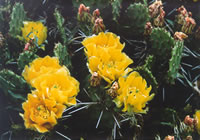Bug in a Rug |
|
| As May melts into June, so too goes the procession of flowers. This spring’s incredible display of Scorpionweeds have faded and the blood-orange blossoms of globemallows have deflated under summer’s heat. Fields of starch-white evening primrose and sego lilies, Utah’s State Flower, are also in the seed-production queue. Even the barrel cacti, the scarlet-flowered hedgehog and the pastel-colored fishhook, are ebbing on the floral tide. Though other plants take up summer’s petal procession, it is the other cactus representative that I wish to highlight. With flattened pads joined together like some Tinker Toy creation, these cacti crank up their floral displays in the early stage of summer. Flowers tend to open slowly in the day, awaiting the daily warmth which, in turn, motivates the insect pollinators that will be spreading the cacti’s genetic heritage. Though there are several species of prickly-pears that grow here, there is often hybridizing that makes identification difficult. And besides, its not really the flowers that are my focus. Sure, the flowers are gorgeous in their yellows, pinks and reds. The numerous yellow stamens located within the flowers are often a stark contrast to the color of the petals. Also, a look inside the flower will often reveal colorful insects wading through the sea of pollen and stamens. But it’s not really these bugs that I want to focus on either. As you investigate these prickly-pears, incidentally named for the spiny pear-shaped fruits, try to find a plant that resembles a causality from the Spitball Wars. Don’t tell me you never participated in one of those nighttime waded-up-tissue, straw-blowgun-delivery wars. I wouldn’t believe you anyway if you tried to deny it. Now your and my childhood are also not the focus of this story, as well. Back to the cacti and one called Opuntia polyacantha, the scientific name for one of these cacti. The name Opuntia is after a plant that grew near Opus in Ancient Greece, while polyacantha means “many spined”. Fall into one and you’ll remember this name forever. But this article is not just about the derivation of plant names. No. It is about bugs in a rug. In particular, the spit-wad resembling scale insect that is found on prickly pear cacti pads. This scale insect is called the cochineal bug (Dactytopius confusus). These cactus-pad flat insects secrete a white waxy material over themselves that protects the insect from predators and the environment. Since the insects don’t move about on the plant, this waxy coating is their final resting stage. Incidentally, confusus means “deceptive” in reference to the insect’s white cover. Cochineal means “scarlet-colored”
and is a very appropriate name for these soft-bodied insects.
Tease aside the white coating and beneath is a quarter-inch
long red bag - the female cochineal bug. By “bag”
I don’t mean old, rather it is a reference to the shape
and texture of this insect. When the Spanish conquistador Hernan Cortes was conquering the Aztecs in the early 1500s, he discovered a highly developed textile industry that produced cloth with brilliant red coloring. The Aztecs had been collecting cochineal bugs and producing a red dye from them. Although this may not be the origin of “bug in a rug” it certainly gives new meaning to the phrase. As most conquerors do, the Spaniards sent bags of dried cochineal insects back to Spain. From there the use of this red dye spread to many countries and for various uses. Michelangelo is said to have used the dye in his paintings, the early British “redcoats” were dyed with cochineal insects, and rumor has it that the first U.S. flag made by Betsy Ross incorporated cochineal red stripes into its pattern. Though synthetic dyes have mostly replaced cochineal sources, the dye is still used in foods, drugs and cosmetics. Peru is the major supplier of the dye, supplying 80% of the world’s cochineal in both dye and insect form. An estimated 50,000 people harvest and process the insects in that country. I wonder if the first native person to squish a cochineal bug realized the ripple effect their action would have on the rest of humanity, on the bug itself and perhaps on a plain-colored rug.
|
|







